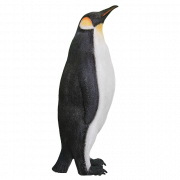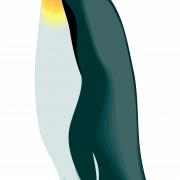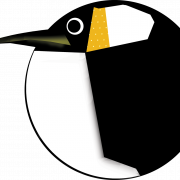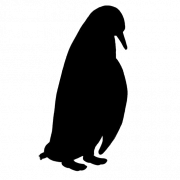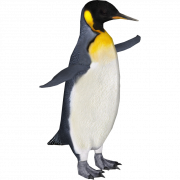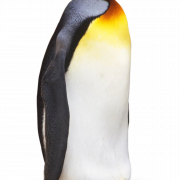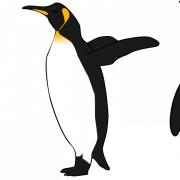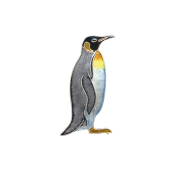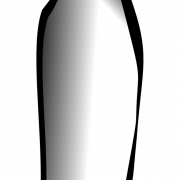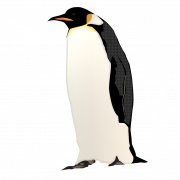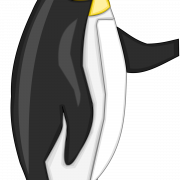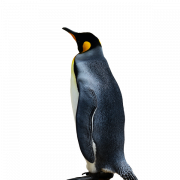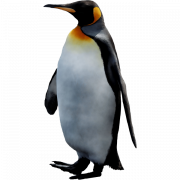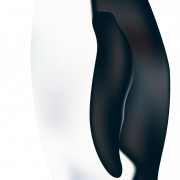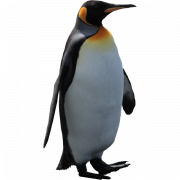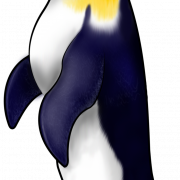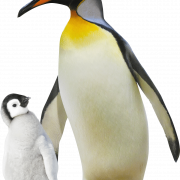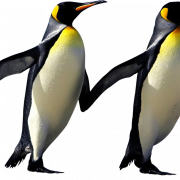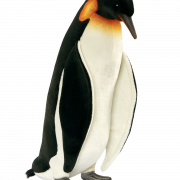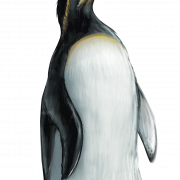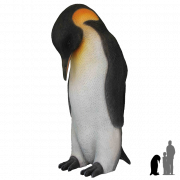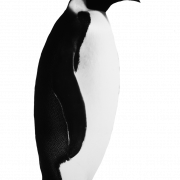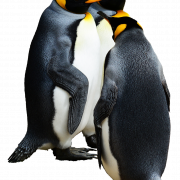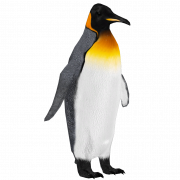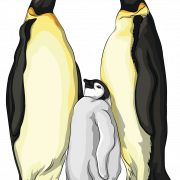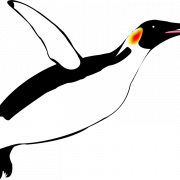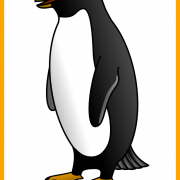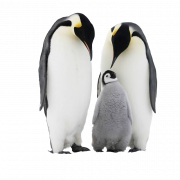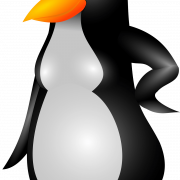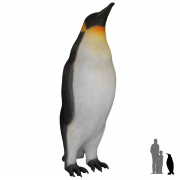Download top and best high-quality free Emperor Penguin PNG Transparent Images backgrounds available in various sizes. To view the full PNG size resolution click on any of the below image thumbnail.
License Info: Creative Commons 4.0 BY-NC
The emperor penguin (Aptenodytes forsteri) is native to Antarctica and is the tallest and heaviest of all extant penguin species. The male and female have comparable plumage and size, reaching a length of 100 cm (39 in) and weighing between 22 and 45 kg (49 to 99 lb). The blackhead and back feathers contrast starkly with the white abdomen, pale yellow breast, and brilliant yellow ear patches.
It is flightless, having a streamlined body and wings stiffened and flattened into flippers for a sea environment, as do all penguins. Its main food source is fish, although it also eats crustaceans like krill and cephalopods like squid. The species can stay down for up to 20 minutes while hunting, descending to a depth of 535 meters (1,755 ft). It has a number of adaptations to help it do so, including uniquely structured haemoglobin that allows it to operate at low oxygen levels, strong bones that decrease barotrauma, and the capacity to slow down its metabolism and turn off non-essential organ functions.
Emperor penguins are the only penguin species that breeds throughout the Antarctic winter, trekking 50–120 kilometers (31–75 miles) over the ice to breeding colonies that can include thousands of individuals. The female lays a single egg, which the male incubates for slightly over two months while the female goes out to eat; the parents then alternate foraging at sea and caring for their young in the colony. In the wild, the average lifetime is 20 years. However, some individuals have been seen to live to be 50 years old.
Emperor penguins were first described in 1844 by English naturalist George Robert Gray, who coined the generic name -o-, “without-wings-diver,” from Ancient Greek word components. It was named after Johann Reinhold Forster, a German scientist who accompanied Captain James Cook on his second trip and formally identified five other penguin species. In 1773–74, Forster may have been the first person to observe the penguins, documenting a glimpse of what he thought was a similar king penguin (A. patagonicus), but given the location, it may very well have been A. forsteri.
The emperor penguin is one of two extant species in the genus Aptenodytes, along with the king penguin. A third species, Ridgen’s penguin (A. ridgeni), has been discovered in New Zealand’s late Pliocene (approximately three million years ago) fossil records. According to studies of penguin behavior and genetics, the genus Aptenodytes is basal, meaning it branched off from a branch that led to all other extant penguin species. This split is thought to have occurred approximately 40 million years ago, based on mitochondrial and nuclear DNA data.
Download Emperor Penguin PNG images transparent gallery.
- Antarctica Emperor Penguin Transparent
Resolution: 756 × 732
Size: 315 KB
Image Format: .png
Download
- Antarctica Emperor Penguin PNG Clipart
Resolution: 640 × 640
Size: 251 KB
Image Format: .png
Download
- Emperor Penguin Transparent
Resolution: 1392 × 2400
Size: 195 KB
Image Format: .png
Download
- Emperor Penguin PNG Clipart
Resolution: 1273 × 1000
Size: 170 KB
Image Format: .png
Download
- Emperor Penguin Bird PNG Free Image
Resolution: 1979 × 2531
Size: 144 KB
Image Format: .png
Download
- Emperor Penguin Bird PNG File
Resolution: 1057 × 1280
Size: 115 KB
Image Format: .png
Download
- Emperor Penguin Bird PNG HD Image
Resolution: 934 × 534
Size: 38 KB
Image Format: .png
Download
- Emperor Penguin Bird PNG Pic
Resolution: 1576 × 1984
Size: 94 KB
Image Format: .png
Download
- Emperor Penguin Chick PNG File
Resolution: 934 × 534
Size: 41 KB
Image Format: .png
Download
- Emperor Penguin Chick PNG HD Image
Resolution: 866 × 866
Size: 375 KB
Image Format: .png
Download
- Emperor Penguin Chick PNG Pic
Resolution: 845 × 1920
Size: 74 KB
Image Format: .png
Download
- Emperor Penguin Chick PNG Download Image
Resolution: 1920 × 1529
Size: 46 KB
Image Format: .png
Download
- Emperor Penguin Bird PNG Download Image
Resolution: 738 × 1287
Size: 48 KB
Image Format: .png
Download
- Emperor Penguin Bird PNG High Quality Image
Resolution: 1002 × 960
Size: 409 KB
Image Format: .png
Download
- Emperor Penguin Bird PNG Images
Resolution: 1200 × 791
Size: 1199 KB
Image Format: .png
Download
- Emperor Penguin PNG Picture
Resolution: 1200 × 717
Size: 72 KB
Image Format: .png
Download
- Emperor Penguin PNG File
Resolution: 655 × 750
Size: 135 KB
Image Format: .png
Download
- Emperor Penguin PNG HD Image
Resolution: 1500 × 1500
Size: 235 KB
Image Format: .png
Download
- Emperor Penguin PNG Pic
Resolution: 1000 × 750
Size: 614 KB
Image Format: .png
Download
- Emperor Penguin PNG Download Image
Resolution: 2036 × 1107
Size: 81 KB
Image Format: .png
Download
- Emperor Penguin Chick PNG High Quality Image
Resolution: 1740 × 1920
Size: 39 KB
Image Format: .png
Download
- Emperor Penguin Chick PNG Images
Resolution: 1000 × 1505
Size: 1040 KB
Image Format: .png
Download
- Emperor Penguin Chick PNG Image File
Resolution: 1280 × 786
Size: 208 KB
Image Format: .png
Download
- Emperor Penguin Bird PNG Image File
Resolution: 1373 × 750
Size: 135 KB
Image Format: .png
Download
- Emperor Penguin Bird PNG Photo
Resolution: 900 × 900
Size: 281 KB
Image Format: .png
Download
- Antarctica Emperor Penguin PNG Free Download
Resolution: 640 × 1280
Size: 63 KB
Image Format: .png
Download
- Emperor Penguin Bird PNG Image HD
Resolution: 947 × 1024
Size: 99 KB
Image Format: .png
Download
- Emperor Penguin Bird PNG File Download Free
Resolution: 684 × 1280
Size: 45 KB
Image Format: .png
Download
- Emperor Penguin Bird PNG Transparent HD Photo
Resolution: 1200 × 1791
Size: 204 KB
Image Format: .png
Download
- Emperor Penguin PNG Image File
Resolution: 600 × 750
Size: 235 KB
Image Format: .png
Download
- Emperor Penguin Chick PNG Photo
Resolution: 600 × 750
Size: 277 KB
Image Format: .png
Download
- Emperor Penguin Chick
Resolution: 600 × 600
Size: 222 KB
Image Format: .png
Download
- Emperor Penguin PNG
Resolution: 556 × 1024
Size: 401 KB
Image Format: .png
Download
- Emperor Penguin PNG Free Image
Resolution: 600 × 600
Size: 268 KB
Image Format: .png
Download
- Emperor Penguin PNG Image
Resolution: 1469 × 708
Size: 989 KB
Image Format: .png
Download
- Emperor Penguin PNG Free Download
Resolution: 699 × 1132
Size: 712 KB
Image Format: .png
Download
- Emperor Penguin PNG High Quality Image
Resolution: 1262 × 1690
Size: 1001 KB
Image Format: .png
Download
- Emperor Penguin PNG Images
Resolution: 1243 × 874
Size: 764 KB
Image Format: .png
Download
- Emperor Penguin PNG Photo
Resolution: 1426 × 1013
Size: 683 KB
Image Format: .png
Download
- Emperor Penguin
Resolution: 1635 × 2048
Size: 1941 KB
Image Format: .png
Download
- Antarctica Emperor Penguin PNG
Resolution: 900 × 643
Size: 42 KB
Image Format: .png
Download
- Antarctica Emperor Penguin
Resolution: 977 × 1829
Size: 455 KB
Image Format: .png
Download
- Emperor Penguin Chick PNG
Resolution: 640 × 640
Size: 231 KB
Image Format: .png
Download
- Emperor Penguin Chick PNG Image
Resolution: 907 × 1394
Size: 314 KB
Image Format: .png
Download
- Emperor Penguin Chick Transparent
Resolution: 1001 × 439
Size: 190 KB
Image Format: .png
Download
- Emperor Penguin Bird
Resolution: 1007 × 1280
Size: 1688 KB
Image Format: .png
Download
- Emperor Penguin Bird PNG
Resolution: 4584 × 7155
Size: 262 KB
Image Format: .png
Download
- Emperor Penguin Bird PNG Image
Resolution: 976 × 976
Size: 455 KB
Image Format: .png
Download
- Emperor Penguin Bird Transparent
Resolution: 1471 × 1920
Size: 276 KB
Image Format: .png
Download
- Emperor Penguin Bird PNG Clipart
Resolution: 936 × 750
Size: 61 KB
Image Format: .png
Download
- Emperor Penguin Bird PNG Free Download
Resolution: 666 × 930
Size: 31 KB
Image Format: .png
Download
- Emperor Penguin Bird PNG Picture
Resolution: 760 × 791
Size: 112 KB
Image Format: .png
Download
- Antarctica Emperor Penguin PNG Image
Resolution: 1211 × 1009
Size: 149 KB
Image Format: .png
Download
- Emperor Penguin Chick PNG Clipart
Resolution: 746 × 702
Size: 212 KB
Image Format: .png
Download
- Emperor Penguin Chick PNG Free Download
Resolution: 800 × 800
Size: 226 KB
Image Format: .png
Download
- Emperor Penguin Chick PNG Picture
Resolution: 1095 × 1920
Size: 194 KB
Image Format: .png
Download
- Emperor Penguin Chick PNG Free Image
Resolution: 640 × 640
Size: 166 KB
Image Format: .png
Download

